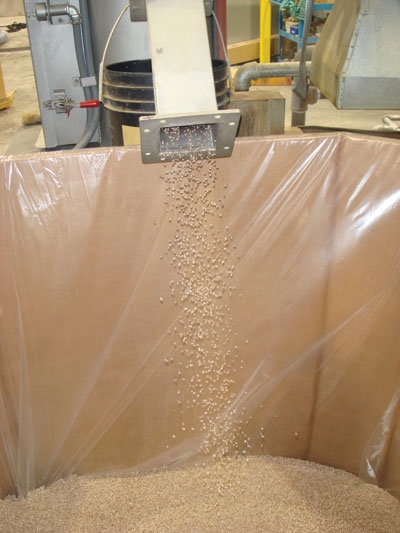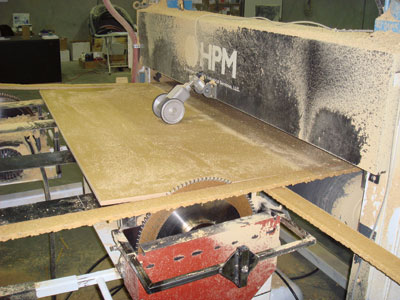
Features
Site Visit
Wood Panels
Just Add Flour
When the manufacturing line starts up at the BC plant housing JER Envirotech International Corporation, it makes the sound of a new opportunity emerging in the Province’s forest industry. It’s the opportunity developed by entrepreneurs who saw how waste could be recycled into a dynamic new product with worldwide demand.
But the sound is also one of missed opportunities for BC’s growing mountain pine beetle wood waste.
November 28, 2011 By Jean Sorensen
 When the manufacturing line starts up at the BC plant housing JER Envirotech International Corporation
When the manufacturing line starts up at the BC plant housing JER Envirotech International Corporation“We could use mountain pine beetle wood,” nods new CEO Edward Trueman, as a bio-plastic wood composite board rolls off the Delta company’s production line at its head office, warehouse, and manufacturing location. It’s feasible to turn MPB waste-wood into the wood “flour” that is a mainstay of JER Envirotech’s product – a plastic-wood sheeting material and pellet – with a worldwide market. “But, we are not doing it,” he says.
The main difficulty is the lack of intermediary processing plants in BC, plus the mill would then have to fine-tune a processing formula for using that MPB wood. “The bio-fibre has to be a specific shape, size and moisture content,” he says, adding that it is conceivable that “we could develop the process to use the material.”
For now, tons of readily available “flour” are arriving from the US, where intermediary mills source and grind waste materials such as rice husks or sawdust, shavings and residuals of oak, maple and pine from mills and processing plants into a powder-like consistency. It is trucked to the Delta manufacturing plant, located only a short drive from the BC – US border. There it is mixed with recycled plastics, which arrive in the form of clear, shotgun-sized pellets. The plastic is heated and the wood flour combined using a tightly guarded process, and then the resulting batch material is extruded in sheet material or in pellet form. Sheets are used for construction, while the pellets are used by the injection molding industry.

Next Phase
Trueman, the newly ensconced US executive who specializes in turning start-ups into going concerns, shows off the stream of sheeting board flowing from the line. It looks like cardboard in colour, but has a plastic hardboard consistency. The product rolling from the line has the thickness of a clipboard. This order, tells Trueman, is destined for the US poultry industry where it will be used as a low-cost and fast means of building chicken-coops. With its plastic consistency, it offers the ability to clean easily.
The poultry industry is by no means the only user of the product, but one of a growing number of industrial niche markets that Trueman is tapping into to power the financial success of JER Envirotech’s technology. The product has not hit the retail level yet, but is distributed to industrial users such as companies that use it for interior/exterior wall cladding, door skins, structural integrated panel boards, laminate flooring substrate, kitchen counter under-lay, outdoor decking (under vinyl), signage backing, ceiling tiles, transport container flooring and walls, agricultural and livestock housing, and even concrete forms.
JERtech thermoplastic sheeting comes in a standard four-foot (122 cm) by eight-foot (244 cm) board, and in thickness ranging from 3 mm to 15 mm. Sheets can also be produced in 10 and 12-foot lengths. As it is an extruded material, the thickness can vary. And, says Trueman, it is possible for thicker sheets to be re-manufactured into lumber or boards for special or value-added clients.
One key factor in the production of the sheathing and pellets is that it is not a commodity item, but rather a customer-driven product where the plant produces according to dimensions and composition that is required for end use. “We have about 50 consumer products that we produce that vary by formula and material,” he said.
The company’s product, which is called a thermoplastic bio-composite, is another plank in the foundation of engineered wood product boards that has entered the market. But, unlike other composite boards, Trueman said, his has no toxic binders. “Our product is non-toxic and our product is non-hydroscopic, so it will not develop dry-rot and it is not compromised in high-humidity areas,” he said.

The bio-composite, manufactured in pellets, is formulated to the customer’s end use in its injection molding application. The company will develop the specified product to meet the customer’s end use. A recent example is Sprig Toys in the US. It is a Colorado toy maker that bills itself as socially and environmentally responsible. In April 2008 it signed a four-year agreement with JER Envirotech for the supply of bio-plastics to make its toys. JER Envirotech has agreed to maintain certain prices for set volumes of materials. JER Envirotech is now the exclusive supplier of bio-plastic material to the toy manufacturer, and this customer specific product will be called Sprigwood. The company estimates that 1.5 million pounds of Sprigwood compound will be manufactured and shipped to meet the toy manufacturer’s production needs.
Moving South
Wastewood pine, derived from mills in Eastern Canada and the southeastern US, and ground to flour by intermediate mills is a major contributing factor to JER Envirotech’s planned expansion into this southern area. Trueman says JER Envirotech will open a second North American manufacturing plant in Greenville, SC in 2008 employing 10 to 15 people (the Delta operation has 35 to 37 employees). The decision to move south is also “market driven”, Trueman adds. “Our customers are really east of the Mississippi, including Toronto. We would be located close to the customers and also our raw materials, and there is just better logistics to the transportation.”
In the southeast US, there are a number of European car manufacturers where the product has a target market in injection molding components for the auto-industry. Trueman is also targeting the auto-industry in Ontario. Trueman adds that the southern area also has a strong “right to work” climate, and a very attractive cost structure for new manufacturers.
The Greenville location will also dovetail with a strong working relationship with Guardian Building Products, located in that city. The company has an order for more than 300,000 pounds of JERtech thermoplastic bio-composite compound to be used in its composite decking line. Guardian has been working with JER Envirotech since late 2006.
While North America is a prime target market, Trueman is looking global, especially at emerging economies in Asia, like the Philippines and Malaysia, where the building material would prove practical. “The application is global,” he explains. The company, which is traded on the Toronto Stock Exchange, also has manufacturing plants in both Malaysia and the Philippines.
In fact, several Filipino immigrants who came to Canada in 1997 originally started JER Envirotech. They looked at a new bio-composite material using wood and plastics, and worked with the National Research Council of Canada to perfect formulas. In 2004, it went public.
“A significant amount of investment – $18 million – went into the process and equipment,” says Trueman, which is one reason he carefully guards the processing formulas, and will not discuss the equipment used in-plant. It’s stock equipment from manufacturers that has been customized to meet JER Envirotech’s needs.
By Canadian forest industry standards, the production sheeting line at JER is modest – equivalent to an added-value line in a mill. But, what JER seems to have captured is a rapid way of extruding and curing plastic board, without the need for cumbersome and expensive presses experienced by other composite product producers. Nor, does it have to go through over-lay stages such as overlay plywood for concrete forming. By the time the sheathing is extruded and rolls down the line, it is ready to be clipped and stacked.
Trueman’s role as new CEO is to foster growth and financial success. The company has not turned a profit during the 10 years of initial development, but he expects 2008 will be different. With new contracts coming in – almost on a monthly basis – it could well be.
Most recently, in May, the company entered into a non-exclusive distribution agreement with Jamplast Inc., a leading North American distributor of bio-polymers, engineered polymers, and commodity-grade thermoplastics headquartered in Ellisville, MS. Jamplast provides more than 30 million pounds of raw thermoplastic material annually worldwide. In the past, limited reliable sources and inconsistent pellet quality has hindered the acceptance of thermoplastics (wood composite material) into the injection molding industry.
Trueman is hoping 2008 is not just a good year, but one that pushes recycled wood and plastic to the forefront of engineered wood-based products. He said the Delta plant now operates five days a week with two shifts, but by year end, more production capacity will be needed to meet growing North American demand.
Print this page